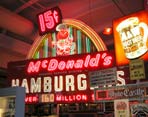
The Automobile and the Environment in American History
Noise, Visual Pollution, and Derelict Cars
While air pollution is the best known and most-discussed environmental impact of operating automobiles, it is not the only one. Traffic noise, while in no manner on a par with air pollution as an environmental hazard, is nonetheless significant. As in other cases, automobiles did not invent noise or noise pollution. Especially in and around cities, throngs of people, factory machinery, steam whistles, the clop-clopping of horse hooves, screeching brakes and grinding gears from streetcars, and clanging bells all contributed to urban din. Indeed, the eventual use of rubber tires on motor vehicles was regarded as a godsend to inner-city traffic. Nonetheless, the volume of motorized vehicles crammed into cities added a new dimension to the noise problem. “While the sources of annoying sounds in a city are plentiful,” one observer noted, “few have been extending their influence as rapidly and relentlessly as the noise of motor vehicles.” While cars are most plentiful, trucks, buses, and motorcycles are guilty of greater sound levels per vehicle. And while traffic noise seldom reaches levels that may produce permanent damage to human health, it can increase stress and contribute to hearing loss, and is at least an irritant and nuisance—and sometimes more.
Cars also contribute indirectly to visual pollution or visual intrusion. The whole automobile infrastructure (discussed more fully below)—paved over landscapes for roads, highways, and parking lots; high-rising cement interchanges; service stations, auto dealerships, and garages; fast food restaurants; strip shopping centers; car washes; and automobile-level billboards, signs, and other forms of advertisements—assault the aesthetic sensibilities of many people.
Possibly the most dramatic form of visual pollution in the automobile age is the derelict car along the side of the road. New York City alone had to contend with 57,000 abandoned automobiles in one year (1969). And scrapped tires create their own land-pollution problem. Before, during, and soon after World War II, rubber from old tires could be reused to make new ones. In the 1960s, however, recycled rubber was in much less demand because of the surplus of synthetic rubber and changes in tire manufacturing, such as the production of steel belted radials. In 1996 there was a national stockpile of about 700 to 800 million scrap tires. Too many tires were left along roadsides or dumped anywhere, creating not only eyesores but good breeding ground for mosquitoes. Fires in tire dumps produced billowing smoke and mounds of toxic sludge. While making tire-derived fuel or producing ground rubber for a variety of uses has been carried out for some time, it is susceptible to market changes.
Other parts of derelict vehicles also cause disposal problems. Probably the most notorious are batteries. In 1986 alone approximately 941,000 tons of lead were used to produce batteries, of which 78 percent was discarded. Other heavy metals, such as cadmium and mercury, are used in great quantities in making batteries and also find their way into the waste stream even after new laws were passed restricting battery disposal practices. Automobiles also generate waste products in the form of plastics, glass, antifreeze, motor oil, transmission and brake fluid, etc.
The good news is that approximately 65 percent of the weight of the average car is composed of steel and iron, metals that are valuable to the steel industry. There are 12,000 auto dismantlers in North America and scores of ferrous scrap dealers. In 2000, more than 14 million tons of steel was recycled from cars, with a recycling rate for automobiles exceeding 95 percent. But despite this recycling effort, automobiles continue to pose an environmental challenge in the United States in any number of ways.
<<Previous Section - Next Section>>
Introduction
Environmental Cost of the Automobile Production Process
Energy Use and the Internal Combustion Engine
Auto Emissions and Air Pollution
Noise, Visual Pollution, and Derelict Cars
The Automobile's Imprint on the Landscape
Suburbanization and the Automobile
Conclusion
Complete Text Printable View
About the Project | Credits | Contact Us | Student & Teacher Resources | Site Map
©2004-2010 Automobile in American Life and Society


